|
|
|
Sort Order |
|
|
|
Items / Page
|
|
|
|
|
|
|
| Srl | Item |
| 1 |
ID:
126690
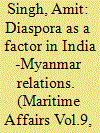

|
|
|
|
|
| Publication |
2013.
|
| Summary/Abstract |
Myanmar' is going through an unprecedented political and socio-cultural trans- formation. During the past five decades of military rule, the country witnessed supprasion of democratic norms/institutions, human rights violations, armed insurgencies by the sidelined ethnic minorities, detention of the opposition activists and leaders, especially the Nobel Peace laureate Ms Aung San Suu Kyi and the economic policies enforced by the junta, and left most of the common people impoverished, including the Indian Diaspora.
|
|
|
|
|
|
|
|
|
|
|
|
|
|
|
|
| 2 |
ID:
126688
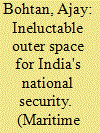

|
|
|
|
|
| Publication |
2013.
|
| Summary/Abstract |
Outer space, or simply space, is the void that exists between celestial bodies. This frontier of outer space is fast emerging as the fourth dimension (after land, sea and air) for military applications. Space will undoubtedly be the military high ground for warfare in the future acting as a "force multiplier" for any military operation. Militarization of space involves use of space technology for exploiting weapons on the ground and in the earth's atmosphere with more accuracy. India has to defend her physical, economic and cultural identity in the prevalent geo-political milieu as it faces varied and complex security challenges. There is a clear and present danger that sooner or later space could be weaponized by various countries. India can no longer be immune to the rapidly changing international security environment, threat to India's national security from nuclear and missile capabilities in its neighbourhood and the vulnerabilities of its space assets. It is therefore imperative that India exploits the capabilities of space, concurrently at appropriate levels, to achieve the desired operational capabilities in a compressed time frame. Since the early 1990s, the Indian armed forces have benefitted from the Indian Space Research Organisation (ISRO) civilian satellites. However, as operational requirements now demand an increase in military capabilities, the armed forces certainly need dedicated military satellites. This space capability has to be optimally exploited by the three services of the Indian defence forces with synergy and harmony, which is possible only under a single appropriate command structure. It is high time that India realizes: "To remain in Race, the Indian armed forces should be in Space".
|
|
|
|
|
|
|
|
|
|
|
|
|
|
|
|
| 3 |
ID:
126687
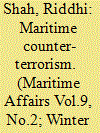

|
|
|
|
|
| Publication |
2013.
|
| Summary/Abstract |
Centre-state relations in India are a fascinating area of studies. The structure of the relationship has an effect on every single aspect of life as we know it in India. This paper is an attempt to study centre-state relations in the context of India's maritime counter-terrorism strategy. Although the Government of India has not publicly stated its counter-terrorism strategy on the sea, intelligence, information sharing, crisis response, finances for internal security and the nation's legislation for battling terrorism together comprise India's maritime-terrorism strategy. Through study of these areas, the paper argues that the centre-state divide has had systemic implications on India's maritime security and has largely done more harm than good to collective initiatives that aspire to prevent future risk of terrorism from the sea or on the sea.
|
|
|
|
|
|
|
|
|
|
|
|
|
|
|
|
| 4 |
ID:
126686
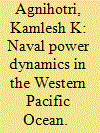

|
|
|
|
|
| Publication |
2013.
|
| Summary/Abstract |
The Western Pacific Region is currently faced with a number of territorial sovereignty disputes and contestations over claimed associated maritime zones. The locus of such disputes lies mainly around the Senkaku/Diaoyu islands in East China Sea; and the Paracel and Spratly chain of islands in the South China Sea. All the disputants are notably engaged in modernising their defense forces, with particular emphasis on naval modernisation. While the pace and quantum of such navy-building is dependent on the individual countries' comprehensive national power (CNP), China and Japan are the leading protagonists. When viewed in the context of long-standing and intractable maritime disputes, the increasing naval capabilities of regional countries adds to the level of their confrontationist postures. This may at times, lead to undesirable outcomes by way of sheer miscalculation. In such an environment, The US decision to 'pivot' to this region brings in huge foreign policy challenges, which it must overcome in order to ensure lasting peace and stability therein.
|
|
|
|
|
|
|
|
|
|
|
|
|
|
|
|
| 5 |
ID:
126689
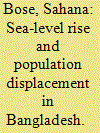

|
|
|
|
|
| Publication |
2013.
|
| Summary/Abstract |
Bangladesh is one of the most vulnerable countries in the world due to climate change and sea level rise (SLR). This has caused large-scale population displacement, human insecurity and illegal migration to India. This paper first analyses the environmental crisis of Bangladesh taking into considerations the problem of SLR, tropical cyclones, soil salinity and mangrove depletion. The second part of the paper discusses its impact on India with special emphasis on the problem of illegal Bangladeshi migration on three areas - North Bengal, Indian Sunderbans Region and North East India. It discusses the possibilities of retaining back the climate-induced migrants through climate change adaptation techniques, people's participation and the bilateral cooperation between India and Bangladesh
|
|
|
|
|
|
|
|
|
|
|
|
|
|
|
|
|
|
|
|
|